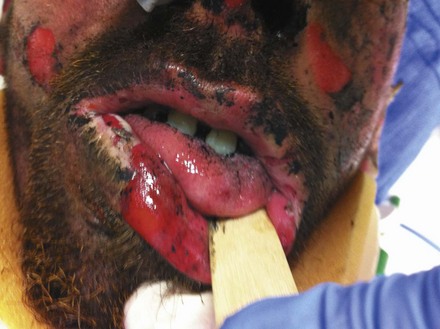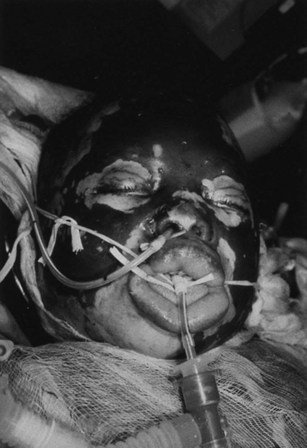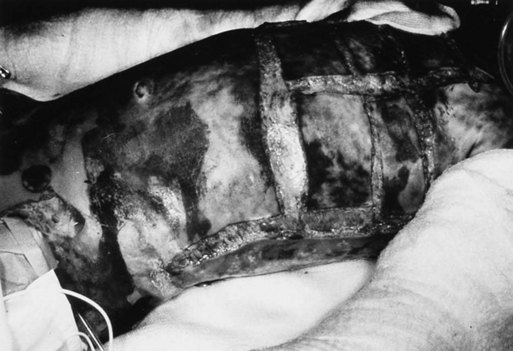Chapter 44 Airway Management in Burn Patients
I Introduction
The National Burn Repository reports 181,000 hospital admissions for burn injury for 1998 through 2007 in 73 U.S. burn centers. The overall mortality rate during this period was 4.9%.1 A 2006 report of the National Burn Repository indicated an incidence of inhalational trauma of 5.7% during the previous 10 years.2 Inhalational burn trauma was associated with a 27.3% mortality rate, compared with a rate of 4.5% for burned patients without inhalational injury.2 A review of 850 children admitted with inhalational injury during a 10-year period at the four Shriner’s Pediatric Burn Centers in the United States found a mortality rate of 16.4%.3 Consequently, inhalational burns contribute significantly to mortality among the burn population. Although the outcomes for survival after burns and the quality of life of burn victims have improved, respiratory complications are an ongoing source of burn morbidity and mortality.
II Airway Management in the Acutely Burned Patient
A Evaluation of the Patient after Acute Burn Injury and Indication for Airway Management
1 Assessment at the Scene
First responders have a crucial role in the early management of burn patients. In addition to the usual trauma assessments, emergency medical service (EMS) staff must determine whether the patient’s condition warrants immediate intubation in the field or the patient can be observed. Indications for intubation at the trauma scene include the following4,5:
• Unconsciousness and altered mental status (with incumbent aspiration risk)
• Respiratory distress (e.g., desaturation with supplemental oxygen [O2], tachypnea)
• Hoarseness, stridor, dysphagia, or drooling
• Burn injury to the neck and face after fire or smoke exposure in a closed space or carbonated sputum
• Prolonged transport to the hospital of the patient with possible airway injury
The practice of prehospital intubation of the burned patient has been questioned. Eastman and colleagues6 reviewed the charts of 1272 patients admitted after field intubation over a period of 23 years and found that 69% of them survived. However, 30% of the survivors were extubated on admission or on the second day after the burn. None required reintubation. Klein and associates7 reviewed the charts of patients admitted to the Washington Burn Center after a transport of more than 90 miles for the period of 2000 through 2003. They examined parameters such as duration of transport, error in burn severity estimation, fluid management, appropriateness of intubation, and transport complications. Of 1877 patients, 424 were transported more than 90 miles to the burn center. No patient died during transport, and 111 patients arrived intubated, with only 61% having inhalational burns. More than 50% of patients were extubated within the first 24 hours after admission.
2 Assessment in the Hospital
Roughly 10% of burn patients also present with other traumatic injuries. All burn patients are considered trauma patients and consequently undergo a primary trauma survey (i.e., the ABCDE algorithm: airway, breathing, circulation, disability, and exposure).8 The extent and surface area of the burn are noted, other traumatic injuries identified and treated, and the airway secured if indicated. The incidence of inhalational trauma, length of hospital stay, and mortality rate are increased for patients presenting with burns and other traumatic nonburn injuries.9
On arrival of the patient at the burn center, the tube position is confirmed with carbon dioxide (CO2) monitoring and auscultation of the lung fields. Uncertainty about endotracheal tube (ETT) placement should be remedied by direct laryngoscopy or fiberoptic bronchoscopy. The mouth, pharynx, and larynx are examined by laryngoscopy to assess edema and identify any burned mucosa and the presence of soot (Fig. 44-1). A radiograph is obtained to verify the ETT position and identify other potential injuries, such as a pneumothorax. Lung parenchymal injuries usually are not immediately detectable by radiography immediately after injury. Patients presenting with a supralaryngeal airway (SLA) on arrival at the hospital require endotracheal intubation or a surgical airway.

Figure 44-1 Carbonaceous sputum, singed nasal hairs, and facial burns indicate possible upper airway thermal injury.
In the unintubated patient, the presence of soot in the sputum, dyspnea, tachypnea, hoarseness, and stridor are signs of impending airway obstruction. Fiberoptic endoscopy is the gold standard for the diagnosis of inhalational trauma.10–17 In the awake patient, a nasal fiberoptic examination under local anesthesia can be performed to evaluate the larynx and confirm the presence or absence of edema and soot. Patients with altered mental status, dyspnea, hoarseness, or stridor require immediate intubation.
A relevant history for airway management after burn injury includes the following information:
3 Altered Mental Status
An isolated burn injury usually does not produce a mental status change early in the disease course. A disoriented, stuporous, or unconscious burn patient should be closely examined for additional trauma. Burn-related reasons for altered mental status include inhalation-induced hypoxemia, CO poisoning, CN toxicity, and electrical injury. Other sources of altered mental status include head trauma, alcohol or drug ingestion, metabolic disorders, seizures, and psychosis. Patients with altered mental status should be intubated and ventilated with 100% O2 until CO poisoning and CN toxicity can be ruled out. Intubation should be performed using maneuvers to stabilize the cervical spine (C-spine) if neck injury has not been ruled out.10,12,17,20,21
4 Cardiovascular Abnormalities
Cardiovascular instability, dysrhythmia, and cardiac arrest can be consequences of CO intoxication. Cardiac disturbances can also result from innate cardiac disease combined with the response to traumatic injury. Hypotension is often caused by fluid loss associated with burns. Hemorrhagic and neurogenic shock can also lead to hypotension in these patients as a consequence of nonburn injuries. The airway should be secured in hemodynamically unstable patients.10,17,22
5 Neck and Face Burns
Extensive burns of the face and neck produce facial edema, making direct laryngoscopy difficult or impossible. These patients may have pharyngeal and laryngeal edema, further complicating intubation (Fig. 44-2). Delay in securing the airway can lead to a “cannot intubate, cannot ventilate” situation. Surgical airways must be performed in this instance.10,17,21,23
6 Extensive Burns
Patients with large body surface area burns frequently have airway burns as well (Fig. 44-3). Edema after resuscitative efforts can make intubation impossible. After massive burns, patients develop a hypermetabolic state leading to increased CO2 production requiring ventilator support. Some physicians suggest prophylactic intubation for total body surface area burns greater than 30%.10,12,17,22
B Inhalational Injury
Approximately 20% to 30% of patients admitted to regional burn centers have some degree of inhalational injury and are at risk from toxic gases.19,24 Edelman and colleagues25 reviewed 829 patients admitted to a burn center between 2000 and 2004 and found that 28% had an inhalational injury. Although the mortality rate for patients with solely a thermal injury was 3% and was 12% for those with an isolated inhalational injury, patients with combined thermal and inhalational injuries had a mortality rate of 14.6%.25 Box 44-1 summarizes smoke inhalational injuries.
Box 44-1 Smoke Inhalational Injuries
• Inhalation injury occurs in 20% to 30% of burn patients.
• Inhalation injury increases burn mortality.
• The leading cause of immediate death from burns is inhalational injury, not the burn itself.
• Heat injury is confined above the vocal cords.
• Inhalation damage is caused by toxic chemicals and thermal injury.
• Sequelae of inhalational burns include pulmonary edema,  mismatch, atelectasis, airway obstruction, and pneumonia.
mismatch, atelectasis, airway obstruction, and pneumonia.
• Carbon monoxide (CO) and cyanide (CN) systemic toxicities should be suspected with burns in confined areas.
1 Injury to the Respiratory Tract
a Upper and Lower Airway Inhalation Smoke Injury
Thermal injury and inhaled chemical toxins cause burn injuries by different mechanisms. In an enclosed environment, temperatures can exceed 800° C, with an O2 concentration of just 10% and CO concentrations greater than 0.5%.26,27 Injuries are often described by the area of the tracheobronchial tree affected. The upper airway lies above the vocal cords, whereas the lower airway consists of the tracheobronchial tree, including the terminal bronchi and alveoli.
The lower airway includes the tracheobronchial system and the lung parenchyma. Most injuries of the upper and lower airway result from the chemical toxins produced by combustion. Burned rubber and plastics release ammonia, chloride, sulfur, and nitrogen dioxides. Cotton and wool fires produce toxic aldehydes, including formaldehyde. Laminated structures produce cyanide.16,21,22,28–30
b Pathophysiology of Smoke Inhalational Injury
NO formed from arginine by nitrous oxide synthetase (NOS) has an important role in pulmonary changes after smoke injury. Smoke inhalation stimulates vasomotor and sensory nerve endings in the tracheobronchial tract, releasing neuropeptides with bronchoconstricting properties. Neutrophil activation produces reactive oxygen species (ROS), increasing the activity of NOS.31
Increased NO in the lung reduces hypoxic pulmonary vasoconstriction, leading to ventilation-perfusion ( )) mismatch and edema formation. O2 and NO react to form peroxynitrite. Peroxynitrite causes cellular injury and damage to cell membranes that results in increased pulmonary vascular permeability and pulmonary edema. Peroxynitrite, other reactive O2 species, and reactive nitrogen (N2) species damage DNA. In an effort to repair damaged DNA, poly(ADP-ribose) polymerase (PARP) is activated. PARP uses ATP energy reserves to repair damaged DNA. Depletion of ATP by PARP activity results in cell death.32–35
)) mismatch and edema formation. O2 and NO react to form peroxynitrite. Peroxynitrite causes cellular injury and damage to cell membranes that results in increased pulmonary vascular permeability and pulmonary edema. Peroxynitrite, other reactive O2 species, and reactive nitrogen (N2) species damage DNA. In an effort to repair damaged DNA, poly(ADP-ribose) polymerase (PARP) is activated. PARP uses ATP energy reserves to repair damaged DNA. Depletion of ATP by PARP activity results in cell death.32–35







